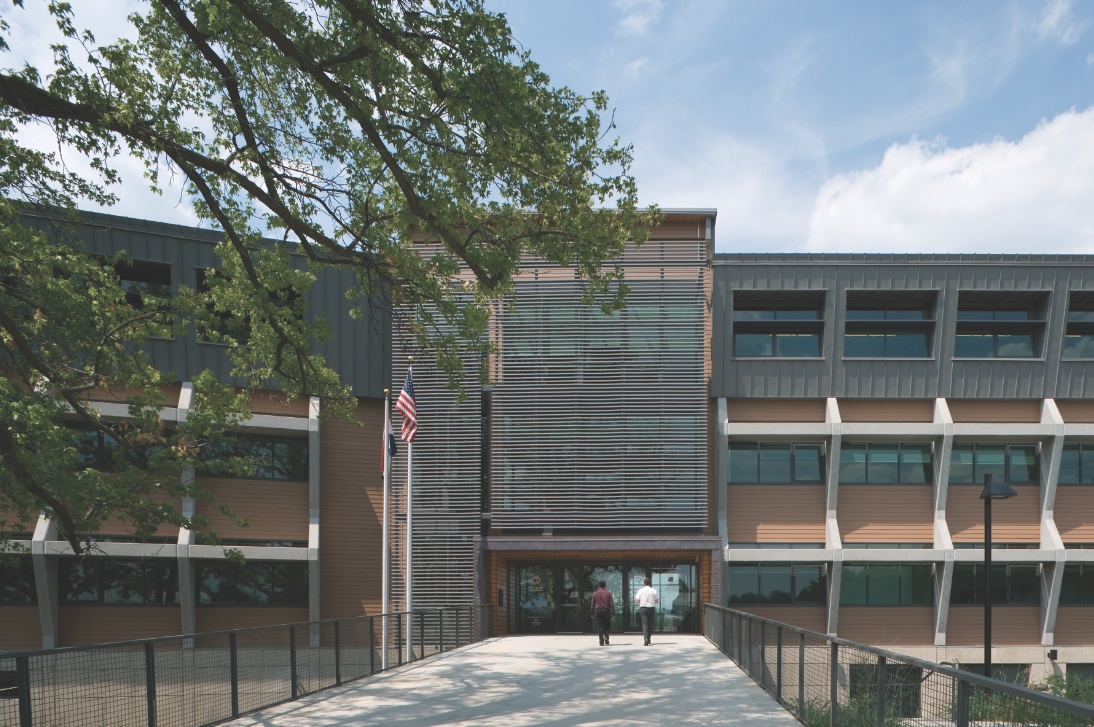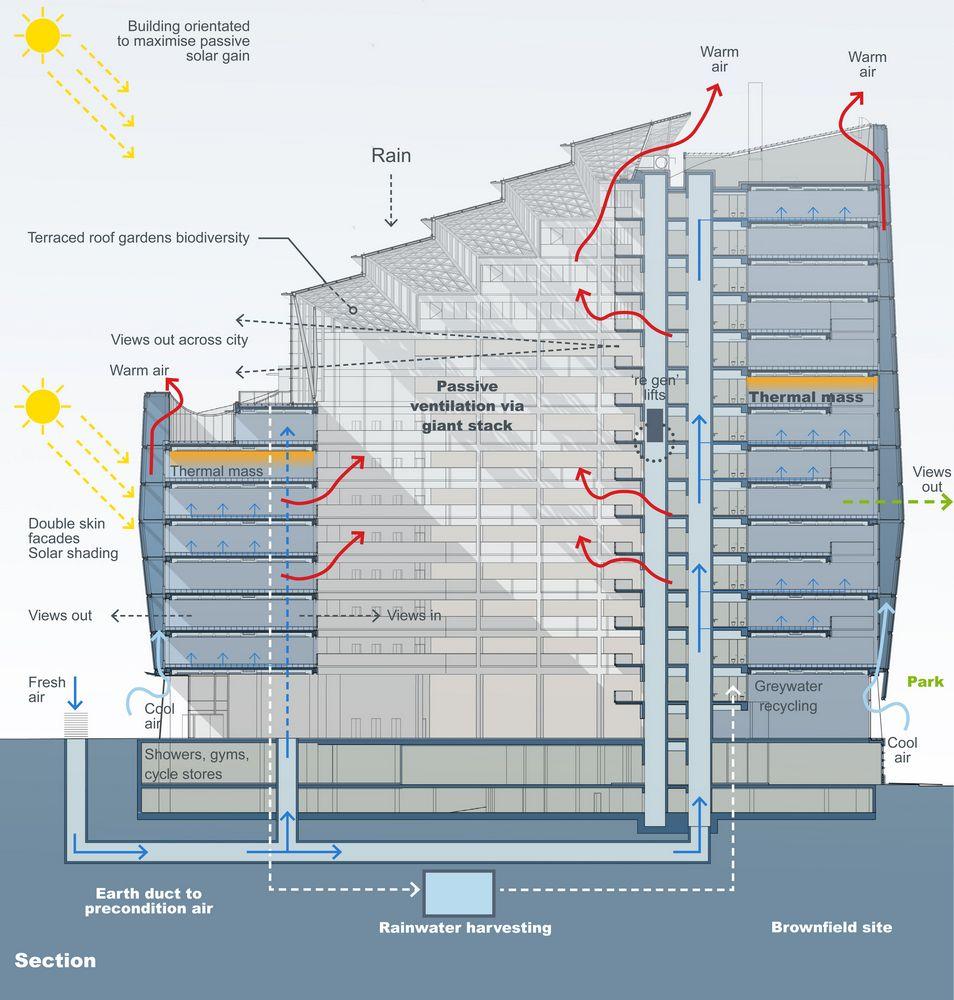For two years, my colleague, architect Ulf Meyer, and I worked on a book, The World’s Greenest Buildings: Promise vs. Performance in Sustainable Design (Routledge), published last January. We were particularly interested in reviewing high-performance green buildings from the U. S. and Canada, as well as those from Europe and the Asia/Pacific region, to see if we could discern some universal goals for green building projects.
We aimed at getting operating data from LEED Platinum (or equivalent) buildings completed since 2003 that represented nonresidential typologies and were at least 50,000 sf in size—in other words, the typical commercial/institutional building type.
In many respects, this work was a follow-up to my 2009 book, Green Building Trends: Europe (Island Press), which looked specifically at European examples and focused on green building technologies and design approaches. What I found in the course of researching that book was a series of great examples of sustainable design and a lively tradition of such buildings that went back 15 years or more.
DATA, DATA, WHO’S GOT THE DATA?
But what was lacking in my study of European green buildings was solid information on actual performance—verifiable data based on real-world field performance that would help link design approaches with actual energy and water use. That was the deficiency that Ulf and I sought to remedy in our research for The World’s Greenest Buildings.
The most surprising result of our two years of research: how few owners of so-called “high-performance” buildings were actually willing (or even able) to share their operating results with us. We ran into this roadblock even with structures built on university campuses or for government agencies?—?the very owners that should, in theory at least, be open to collecting and dispensing such information.
In fact, nothing in law or professional practice compels building owners to share such data. Without feedback from actual operating data, though, how are designers and their project partners supposed to do a better job? (To my mind, it’s a scandal that the standard AIA contract does not require building owners to disclose operating data to their Building Teams and allow them to publish it, a change that the AIA could easily make in support of its commitment to the 2030 Challenge.)
Holabird & Root Architects and Engineers and The Weidt Group worked with contractor Boldt Construction on the $63 million Regents Hall of Natural and Mathematical Sciences at St. Olaf College, Northfield, Minn. The 190,400-sf lab building uses a heat-recovery loop, a so-called “cascade” air system, and a low-flow, variable-air-volume fume hood exhaust system to control energy use. Photo: Don F. Wong/Courtesy Holabird & Root
Fortunately, the landscape is shifting dramatically, partly as a result of a number of local initiatives in cities like New York, Seattle, San Francisco, Austin, Texas, and Washington, D.C., that require owners of buildings of more than 50,000 sf to disclose operating data in publicly accessible databases. (California’s AB 1103 law now requires energy use disclosure, but only when a whole building is sold or leased, so it’s going to be a while before we have any significant data from that mandate.) Fast-forwarding to 2015, we’re likely to have much more data to feed back to building designers, contractors, owners, and operators.
In The World’s Greenest Buildings, we did our best to locate and solicit data from 55 high-performance projects from the three major regions of the world where sustainable design has taken off: North America (15 from the U.S., three from Canada), Europe, and Asia/Pacific (including five from Australia). The lone Latin American project, the Transoceánica office building, in Santiago, Chile, was actually among the lower energy users in the world, which taught us that there are surprises everywhere!
Of the U.S. projects we studied, four were located in the Midwest: Great River Energy Headquarters, Maple Grove, Minn.; Lewis and Clark State Office Building, Jefferson City, Mo.; Regents Hall of Natural & Mathematical Sciences, St. Olaf College, Northfield, Minn.; and Johnson Controls Campus, Glendale, Wis. In the end, we were able to gather building operating data from projects in 18 countries and compare the data within a region as well as across regions.
SET YOUR ENERGY TARGET FROM THE START
Here are a few key lessons that can be derived from the book:
1. In your next building project, you should be able to achieve the same energy and water use as LEED Platinum buildings around the world, because there is nothing magical or geographically specific about good design. What is required is a specific (and early) intent by the entire Building Team to meet clear numerical targets for energy and water use. We found that an energy use intensity (EUI) of 35 (35,000 Btu/sf/year) before adding contributions from renewables can be achieved.
2. What makes high-performance projects stand out is the commitment of owners and their Building Teams to achieving “best-in-class” results. The projects we studied were all LEED Platinum, which means they started with high-performance energy-efficiency goals. What also stands out is the commitment to an integrated design process; it’s almost always the case that without the right process, you can’t get the best outcome.
Great River Energy Headquarters, Maple Grove, Minn., uses underfloor air distribution and generous daylighting, as well as a lake-source geothermal system. Perkins+Will (architect/interior design) led the Building Team of BKBM Engineers (SE), Dunham Associates (MEP), RLK Inc. (CE), and McGough (GC) on the $65 million, 166,000-sf office building for the second-largest electric power supplier in Minnesota. Photo: Paul Crosby / Courtesy Perkins+Will
3. Most surprisingly, high-performance green design uses about the same energy everywhere in the world, from Northern Europe to the tropics. Typically, once you have a good building envelope and efficient HVAC systems in place, half the remaining energy use comes from plug/process loads and lighting, which tend to be geographically about the same in office buildings, leaving only about 15-20% for heating/cooling loads. In the northern latitudes, most loads are devoted to heating in winter, while in the tropics, most loads are devoted to cooling; these more or less balance out over the course of the year.
4. Great green buildings are just as beautiful, if not more so, than buildings with ordinary energy and water performance. Perhaps it is beauty itself that should be our goal in sustainable design. One of the core tenets of our book is that there is no inherent conflict between buildings with architectural merit and those with high-performance green characteristics (such as those with LEED Platinum status) and low-energy outcomes.
5. The last lesson from our research is that there are no standard definitions of building energy use, no good ways to tease out core energy use from special operations such as onsite data centers. In fact, in Australia, we were surprised to find that building energy use is typically reported only for the base building, leaving out tenant loads in commercial offices, a practice that dramatically understates actual energy use. (This is also the case in many European countries.) We hope that researchers in this field will make sure that we can arrive at common definitions, so that comparisons across countries will become much easier in the future.
What does this mean for the U.S. design and construction community?
First, you should aim at having every office and academic building you work on use less than 35,000 Btu/sf/year for “core” uses (i.e., excluding data centers and special process loads such as wet labs), before adding any contribution from renewables.
Second, there are plenty of great design strategies from around the world that are available and that will work in the cold winters and hot/humid summers of the Midwest.
Third, and perhaps most important, an integrated design process is essential for achieving great results.
Author ID: Jerry Yudelson, PE, LEED Fellow, is CEO of Yudelson Associates, a green building and sustainability consultancy in Tucson, Ariz., and author of 13 books on green building, green homes, sustainable development, and water conservation. He has keynoted more than 50 green building conferences since 2007 and delivered the keynote address at the 2013 BUILDINGChicago/Greening the Heartland show.
Related Stories
AEC Tech | Oct 16, 2024
How AI can augment the design visualization process
Blog author Tim Beecken, AIA, uses the design of an airport as a case-study for AI’s potential in design visualizations.
Airports | Aug 22, 2024
Portland opens $2 billion mass timber expansion and renovation to its international airport
This month, the Portland International Airport (PDX) main terminal expansion opened to passengers. Designed by ZGF for the Port of Portland, the 1 million-sf project doubles the capacity of PDX and enables the airport to welcome 35 million passengers per year by 2045.
Smart Buildings | Jul 25, 2024
A Swiss startup devises an intelligent photovoltaic façade that tracks and moves with the sun
Zurich Soft Robotics says Solskin can reduce building energy consumption by up to 80% while producing up to 40% more electricity than comparable façade systems.
Great Solutions | Jul 23, 2024
41 Great Solutions for architects, engineers, and contractors
AI ChatBots, ambient computing, floating MRIs, low-carbon cement, sunshine on demand, next-generation top-down construction. These and 35 other innovations make up our 2024 Great Solutions Report, which highlights fresh ideas and innovations from leading architecture, engineering, and construction firms.
Airports | Jun 3, 2024
SOM unveils ‘branching’ structural design for new Satellite Concourse 1 at O’Hare Airport
The Chicago Department of Aviation has revealed the design for Satellite Concourse 1 at O’Hare International Airport, one of the nation’s business airports. Designed by Skidmore, Owings & Merrill (SOM), with Ross Barney Architects, Juan Gabriel Moreno Architects (JGMA), and Arup, the concourse will be the first new building in the Terminal Area Program, the largest concourse area expansion and revitalization in the airport’s almost seven-decade history.
Products and Materials | May 31, 2024
Top building products for May 2024
BD+C Editors break down May's top 15 building products, from Durat and CaraGreen's Durat Plus to Zurn Siphonic Roof Drains.
Biophilic Design | May 6, 2024
The benefits of biophilic design in the built environment
Biophilic design in the built environment supports the health and wellbeing of individuals, as they spend most of their time indoors.
Architects | May 2, 2024
Emerging considerations in inclusive design
Design elements that consider a diverse population of users make lives better. When it comes to wayfinding, some factors will remain consistent—including accessibility and legibility.
Airports | Apr 18, 2024
The next destination: Passive design airports
Today, we can design airports that are climate resilient, durable, long-lasting, and healthy for occupants—we can design airports using Passive House standards.
Airports | Feb 13, 2024
New airport terminal by KPF aims to slash curb-to-gate walking time for passengers
The new Terminal A at Zayed International Airport in the United Arab Emirates features an efficient X-shape design with an average curb-to-gate walking time of just 12 minutes. The airport terminal was designed by Kohn Pedersen Fox (KPF), with Arup and Naco as engineering leads.



















